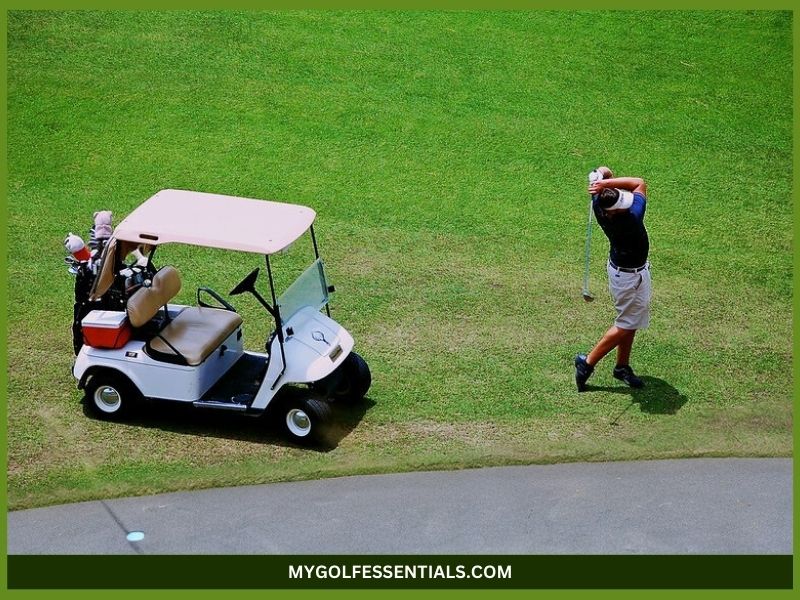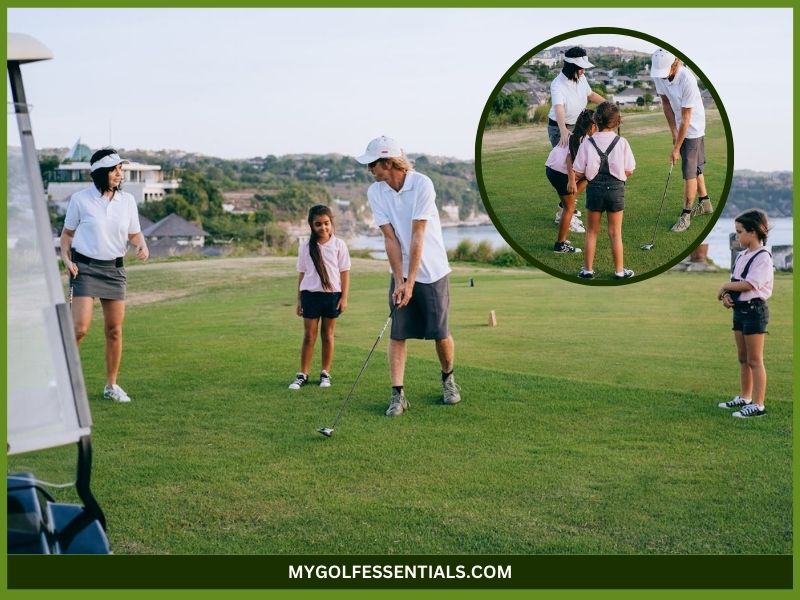
Golf can be a lot of fun. But in the meantime knowing the rules is also equally important in order to have a great experience on the course. One area that often confuses players is what to do when their ball lands on a cart path. That’s where this article comes into play so that to help you overcome this issue.
In this article, we will explain how to take relief from cart paths according to the official rules. It will ensure you know exactly what to do when faced with this common course conundrum. To gain this knowledge, it doesn’t matter whether you are a beginner or have been playing for years. Whatever the case, understanding these rules will help you avoid penalties and play better.
So, without further ado, let’s get started to read on and learn how to take relief correctly, avoid penalties, and keep your game running smoothly!
What is a Cart Path?
A cart path is a designated route on a golf course, typically paved or marked, that is used by golf carts to travel from one hole to the next without causing damage to the course. These paths are usually made of concrete, asphalt, gravel, or other durable materials to withstand the traffic of carts.
[Cart Path – Photo Credit to Mikhail Nilov from Pexels ]
Why Golfers Need Relief From Cart Paths?
Golfers need relief from cart paths when their ball ends up on or near these designated routes, creating an obstruction that affects their stance or swing. Furthermore, playing from a cart path can be difficult and potentially harmful, as it risks damaging clubs and causing injury to the golfer.
To address these concerns, the official golf rules allow players to take free relief from immovable obstructions like cart paths.
When taking relief, the golfer must find the nearest point of complete relief that is not closer to the hole and drop the ball within one club length of that spot.
However, if the cart path is composed of a natural surface such as sand, it is treated as part of the general area, and free relief is not provided.
In some situations, a golfer might decide that playing the ball from the cart path is the best option available.
[When Relief is allowed for abnormal course conditions]
By understanding and following these rules, golfers can avoid unnecessary penalties and ensure their safety and equipment remain intact, all while maintaining the flow of the game. Knowing when and how to take relief can help golfers navigate challenging situations and improve their overall performance on the course.
USGA Rules for Relief
The United States Golf Association (USGA) provides official rules for taking relief from cart paths to ensure consistency and fairness in the game.
According to their rules,
- If your ball lies on or near a cart path or the path interferes with your stance or swing, you may take relief without penalty.
- To take relief, find the nearest point of complete relief from the cart path, no closer to the hole.
- Mark the spot with a tee, then drop the ball within one club length of that spot.
- If the ball settles closer to the hole after being dropped, re-drop it.
- If the ball still settles closer to the hole after a second drop, place it at the nearest spot, not nearer the hole where it first struck the ground.
However, if the cart path is made of a sandy or natural surface, it is considered part of the general area, and you are not entitled to free relief. In rare cases, playing the ball from the cart path may be the best option.
Overall, these rules are designed to help golfers avoid damage to their clubs and prevent injury, all while maintaining the integrity of the game. Therefore, it’s important for golfers to familiarize themselves with these USGA guidelines so they can make the right decisions when encountering cart paths and other similar obstructions on the course.
How to Determine the Nearest Point of Relief
When taking relief from a cart path, you must find the nearest point where the path no longer interferes with your stance, swing, or ball lie. This is known as the nearest point of complete relief.
How To Find the Nearest Point,
To locate the nearest point of relief:
- Stand in the position you would be in if you were playing the ball from its current lie, with your feet in the stance you would take.
- Swing the club back and forth to simulate your intended swing.
- Determine the nearest point where the cart path no longer interferes with your stance or swing.
This point may be to the right, left, or behind the cart path, but it cannot be closer to the hole than your current lie.
Direction of Relief,
The nearest point of relief can be in any direction relative to the cart path as long as it meets below criteria:
- It is the nearest point where the path no longer interferes with your stance, swing, or ball lie.
- It is no closer to the hole than your current lie.
- It is in the same area of the course (e.g., same closely mown area, same bunker, same putting green, etc.).
Once you have determined the nearest point of relief, mark the spot with a tee or other object. Then, drop the ball within one club length of the marked spot, no closer to the hole.
By understanding how to properly determine the nearest point of relief, you(as a golfer) can take advantage of the relief rules provided by the USGA to play fairly and safely without risking penalties or damage to their equipment.
Furthermore, if you are unsure, feel free to consult your playing partners or a rules official for guidance.
Dropping the Ball
Once you have determined the nearest point of relief from the cart path, it’s essential to follow the correct procedures for marking the spot, measuring the club length, and dropping the ball.
1. Mark the Nearest Point of Relief
To mark the nearest point of relief, you can use a tee to mark the exact location where the cart path no longer interferes with your stance, swing, or ball lie. This point ensures that you have complete relief from the obstruction and provides a reference for the next steps in the relief process.
2. Measure Club Length
After marking the nearest point of relief, the next thing you need to do is to measure one club length from the marked point. For that, you can follow below steps:
- Select a Club: Choose the club you plan to use for your next shot(usually the longest one in your bag, such as a driver).
- Measure the Club Length: To measure the club length, you can hold the club vertically at the marked point, with the grip end on the ground.
- Mark the Area: Extend the club horizontally away from the marked point in any direction (right, left, or behind) to find the limit of one club length. In the meantime, keep in mind to ensure that this area is not closer to the hole than your original lie. Furthermore, you can use another tee or object to mark the outer boundary of this one club length area.
3. Dropping Procedure
Now that you have marked the area for dropping the ball, you can follow below steps to drop the ball correctly:
- Position the Ball: Hold the ball in your hand and stand at the marked spot.
- Drop the Ball: Drop the ball from shoulder height. It must fall freely and not be thrown or placed(without any force or spin).
- Ensure Proper Landing: Keep in mind that the ball must land and come to rest within this defined area. And it must not be closer to the hole than the original spot where relief was being taken. If the ball rolls outside this area or closer to the hole, then you may have to drop it once again.
By following these steps carefully, you can ensure that you are taking relief correctly and in accordance with the USGA rules. This will help you avoid any penalties and keep your game flowing smoothly.
Stance and Swing Interference
When playing golf, a cart path can interfere not only with the lie of the ball but also with a player’s stance and swing. If your stance or swing is impacted by the cart path(even if your ball is not on it), you are still entitled to take relief according to the Rules of Golf.
Relief for Stance or Swing
Even if your ball is not directly on the cart path, you are still entitled to relief if the path interferes with your stance or swing. This means that if standing or making a normal stroke would place your feet, body, or club on the cart path, you can take relief under the rules.
Here, the aim is to ensure that you can play your shot without any obstruction or interference from the cart path, maintaining fair play and minimizing the risk of injury.
How to Find Complete Relief
To find the point of complete relief, follow these steps:
- Simulate Your Stance: Stand as if you are addressing the ball, swinging your club back and forth to see how the cart path affects your movement.
- Identify the Nearest Point: Look for the closest spot where the cart path does not interfere with your stance or swing. This point can be to the right, left, or behind the cart path but must not be closer to the hole than your original ball position.
- Mark the Spot: Once you have identified the nearest point of relief, mark it with a tee or other object to ensure you drop the ball correctly.
By following these guidelines, you can effectively take relief from a cart path that impacts your stance or swing, allowing you to play your next shot without penalty.
Hitting from the Cart Path
While taking relief from a cart path is often the preferred option, there may be situations where playing the ball from the path itself is the best course of action. However, it’s important to be aware of the potential challenges and risks involved when playing on such conditions.
Playing the Ball from the Path
If you determine that taking relief from the cart path will result in a more difficult shot or leave you with an unfavorable lie, you have the option to play the ball as it lies on the path. This decision should be carefully considered, as hitting from a hard surface like a cart path can present unique challenges.
Challenges of Hitting from the Cart Path
When playing from a cart path, golfers may encounter the following issues:
- Ball Flight: The hard surface of the cart path can cause the ball to react differently than it would from the grass. The ball may come off the club face with more speed and a lower trajectory, making it more difficult to control.
- Club Damage: Hitting a shot from a cart path can put significant stress on your club, potentially causing damage to the clubhead or shaft over time. This is especially true if you mishit the shot and strike the path directly.
- Uneven Lies: Cart paths are not always perfectly flat, and you may encounter an uneven or sloped lie that makes it challenging to make a clean, solid contact with the ball.
Despite these challenges, playing from the cart path can sometimes be the best option, especially if taking relief would leave you with a more difficult shot.
However, it’s crucial to weigh the risks and potential consequences before making this decision.
Sprinkler Head Relief
Similar to cart paths, the same relief rules apply to sprinkler heads and other artificial objects on the golf course. Sprinkler heads are classified as immovable obstructions under the Rules of Golf, specifically governed by Rule 16. This means that if your ball lies on or near a sprinkler head or if the sprinkler head interferes with your stance or swing, you are entitled to free relief.
When taking relief from a sprinkler head, the process is similar to that of a cart path. You must find the nearest point of complete relief where the sprinkler head no longer interferes with your intended stance or swing. This point can be in any direction. But keep in mind that it must not be closer to the hole than your original ball position.
By following these guidelines, you(as a golfer) can ensure they are playing within the rules while minimizing the impact of these artificial obstructions on their game.
Final Thoughts
Knowing the rules surrounding cart paths is essential for every golfer, whether you’re a beginner or a seasoned player. Proper relief can help you avoid penalties, protect your equipment, and ensure a smooth round.
Yes, playing from a cart path might seem like a viable option in certain situations. Yet it comes with its own set of challenges, such as ball control issues and potential damage to your clubs.
By familiarizing yourself with the official guidelines, including how to find the nearest point of relief and properly drop the ball, you can confidently navigate these situations and focus on your game.
Ultimately, mastering these rules will enhance your golfing experience, keeping your game fair, safe, and enjoyable.
Key Points
- A cart path is a designated route on a golf course for carts, usually made of durable materials like concrete or asphalt.
- Golfers require relief from cart paths to avoid obstruction to their stance or swing, as well as to prevent damage to their clubs.
- Players can take free relief from a cart path if it interferes with their ball’s lie, stance, or swing, by finding the nearest point of complete relief.
- The nearest point of relief is where the cart path no longer interferes with your stance, swing, or ball lie, and it must not be closer to the hole.
- Once the nearest point of relief is found, mark it with a tee and measure one club length from that spot, ensuring the new location is not closer to the hole.
- Drop the ball from shoulder height within the measured area. If it rolls closer to the hole, re-drop, and if necessary, place the ball.
- Even if the ball isn’t on the cart path, players can take relief if their stance or swing is affected by the path.
- Playing from the cart path is allowed but can result in ball flight issues, potential damage to clubs, and difficulty in controlling the shot.
- Choosing whether to take relief or play from the path should be based on assessing the difficulty of the next shot and potential risks.
- The same relief rules for cart paths apply to sprinkler heads and other immovable obstructions on the course.
FAQs
What are the official rules for taking relief from a cart path?
The official rules, as provided by the USGA, allow golfers to take free relief from a cart path if their ball, stance, or swing is interfered with by the path. The nearest point of relief must be identified, and the ball can be dropped within one club length from that point, no closer to the hole.
How do you determine the nearest point of relief from a cart path?
The nearest point of relief is the spot where the cart path no longer interferes with your stance, swing, or ball lie. It can be to the left, right, or behind the cart path but must not be closer to the hole.
Can you play the ball from a cart path?
Yes, you can choose to play the ball from the cart path if the relief options are not favorable to you. However, this is often not recommended due to the potential risk of damaging your club or affecting the ball’s flight.
Do the same rules apply to sprinkler heads as they do to cart paths?
Yes, the same rules for relief apply to sprinkler heads and other artificial objects as they do to cart paths. The process of finding the nearest point of relief and dropping the ball is identical.
What should you do if your stance is affected by a cart path, but your ball is not on it?
If your stance or swing is impacted by the cart path, even if the ball is not directly on it, you are still entitled to relief. You should find the nearest point where the path no longer interferes with your stance or swing, then proceed with the relief process.



